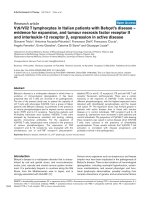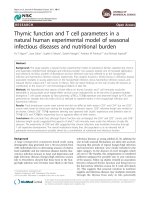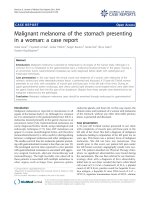Báo cáo y học: " Abdominal wall and labial edema presenting in a girl with Henoch-Schönlein purpura: a case report" pptx
Bạn đang xem bản rút gọn của tài liệu. Xem và tải ngay bản đầy đủ của tài liệu tại đây (502.2 KB, 4 trang )
CAS E REP O R T Open Access
Abdominal wall and labial edema presenting in a
girl with Henoch-Schönlein purpura: a case report
Rania Hiram-Karasmanis
1
, Ronald Garth Smith
1*
, Maria Radina
2
, Donald Allen Soboleski
3
Abstract
Introduction: Henoch-Schönlein purpura is a common immunoglobulin A-mediated vasculitic syndrome in
children, characterized by purpuric rash, arthritis and abdominal pain. Renal involvement, manifested by the
presence of hematuria and/or proteinuria, is also frequently seen. In most cases, patients with this disease achieve
complete recovery, but some progress to renal impairment. Gastro-intestinal manifestations are present in two-
thirds of affected patients and range from vomiting, diarrhea, and peri-umbilical pain to serious complications such
as intussusception and gastrointestinal hemorrhage.
Case presentation: We report the case of a 7-year-old Caucasian girl who presented with abdominal pain, labial
swelling, and a large abdominal ecchymosis two weeks after having been diagnosed with Henoch-Schönlein
purpura. A computed tomography scan revealed abdominal wall edema extending to the groin, without any intra-
abdominal pathology. She was successfully treated with intravenous steroids.
Conclusion: Circumferential anterior abdominal wall edema and labial edema have never been reported
previously, to the best of our knowledge, as a complication of Henoch-Schönlein purpura. These findings further
contribute to the wide spectrum of manifestations of this disorder in the literature, aiding in its recognition and
management.
Introduction
Henoch-Schönlein purpura (HSP) is an IgA-mediated
vasculitis that presents with the common tetrad of
abdo minal pain, arthritis, purpuric rash and renal invol-
vement. It is usually a benign disease of childhood, typi-
cally affecting children between the ages of four and
seven years, who achieve complete recovery in most
cases. HSP is often preceded by an upper respiratory
tract infection, with Group A beta-hemolytic streptococ-
cus responsible for up to 50% of the occurrences [1].
ThediagnosticcriteriaoftheAmericanCollegeof
Rheumatology for HSP are the following: palpable p ur-
pura; patient is aged 20 years or above; acute abdominal
pain; and biopsy showed granulocytes in the walls of
small arterioles or venules [2].
The presence of two or more of these criteria has a
sensitivity and specificity of 87.1% and 87.7%, respec-
tively, for the diagnosis of HSP. A subsequent review of
the classification of childhood vasculitides was carried
out in 2005 and the diagnostic criteria modified
(EULAR/PReS consensus report, 2006) [3]. These new
criteria include:
Palpable purpura (mandatory criterion) in the pre-
sence of at least one of the following four features: Dif-
fuse abdominal pain; any biopsy showing predominant
IgA deposition; arthritis (acute, any joint) or arthralgia;
renal involvement (any hematuria and/or proteinuria).
Gastrointestinal manifest ations seen with HSP have
been well descr ibed, and vary in their severity. In a study
of 100 patients with HSP, Sauls bury reported that 63% of
patients complained of abdominal pain [1] with typical
symptoms including colicky abdominal pain, vomiting and
gastrointestinal bleeding. Gastro-intestinal sym ptoms are
the result of extravasation of blood and fluid into the
bowel wall, leading to ulceration of the bowel mucosa and,
eventually, bleeding, commonly involving the jejunum and
ileum [4] . Intussusception is a rare but serious complica-
tion of HSP, occurring in 1-5% of patients [4]. In the past
few years, there have been several case reports of new gas-
tro-intestinal manifestations of HSP, including hemorrha-
gic ascites [5], perforation of large and small bowel [6],
pancreatitis [7] and ischemic necrosis of the bile ducts [8].
* Correspondence:
1
Department of Pediatrics, Queen’s University, Kingston, ON, Canada
Hiram-Karasmanis et al. Journal of Medical Case Reports 2010, 4:98
/>JOURNAL OF MEDICAL
CASE REPORTS
© 2010 Hiram-Karasmanis et al; licensee BioMed Central Ltd. This is an Open Access article distributed under the terms of the Creative
Commons Attribution License ( which permits unrestricted use, distribution, and
reproduction in any medium, provided the original work is properly cited.
Ultrasound is typically the modality of choice for
investigation of abdominal pain associated with H SP,
and can detect mural thickness and hematoma, ileus,
peritoneal fluid and intussusception [9].
The treatment of HSP remains mainly supportive, as
the acute symptoms resolve spontaneously in the major-
ity of patients. For more severe cases with serious com-
plications of the disease, treatment commonly includes
corticosteroids, immunosuppressive drugs, and plasma-
pheresis [10]. The use of corticosteroids in the treat-
ment of HSP remains anecdotal, as no prospective
placebo controlled trials have been done [1]. A recent
systematic review has been carried out by Weiss et al.
in 2007 [11].
Case presentation
A previously healthy 7-year-old Caucasian girl was
admitted to our hospital with a history of abdominal
pain, labial swelling and a large ecchymosis extending
from the left subcostal area to the left lower quadrant.
Two weeks before being admitted to the hospital, she
experienced symptoms of an upper respiratory infection
followed by joint discomfort, peripheral edema and a
palpable, purpuric rash. She presented to a smaller
community hospital, where the additional findings of
hypertension and a Group A beta-hemolytic streptococ-
cus-positive throat swab were discovered by a consulting
pediatrician. She was diagnosed with Henoch-Schönlein
purpura (HSP) and treated with two weeks of Penicillin
V for her tonsillitis. Her symptoms improved, but over
the course of the next six days, she developed increasing
abdominal pain and “distention”. She also experienced
significant pain in her genital area with associated labial
swelling. She was transferred to our institution, a ter-
tiary care Pediatric Center, for further evaluation. There
was no history of abdominal trauma.
On admission, she was found to be hypertensive, with
a blood pressure just above the 90th percentile for age
and height. She had an exudative plaque on the left ton-
sil, but a throat swab was negative. Her abdomen
revealed a large ecchym osis, 10 cm in diameter over the
left quadrant, with significant edema/swelling extending
from the left flank to the labia majora (Figure 1). The
abdomen was diffusely tender to palpation, and a faint
raised papular rash was noted o n her lower a bdomen,
buttocks and lower extremities. A co mplete blood co unt
revealed a leukocytosis with a left shift and a normal
platelet count. Urine analysis was positive for blood
(microscopic) and an abdominal ultrasound was “nor-
mal” but incomplete. The ultrasound was performed to
rule out intussusception, but had to be a bandoned due
to the extreme abdominal wall tenderness. A computed
tomography (CT) scan of the abdomen was then per-
formed, and this revealed markedly increased a ttenua-
tion within the subcutaneous tissues of the left side of
the abdominal wall and flank, extending to the groin
and labia majora, consistent with hemorrhage or edema
(Figure 2, 3). No intra-abdominal pathology was seen.
Figure 1 Abdominal ecchymosis. Large ecchymosis over the left lower quadrant and edema of the left flank.
Hiram-Karasmanis et al. Journal of Medical Case Reports 2010, 4:98
/>Page 2 of 4
Our patient was treated with 2 mg/kg/day of intrave-
nous methylprednisolone for 48 hours, and then
switched to 2 mg/kg/day of oral prednisone for seven
days. Within 36 hours of initiation of treatment, her
abdominal pain and distention improved significantly
and her hematuria resolved.
Discussion
The reported case describes circumferential anterior
abdominal wall edema and l abial edema as a complica-
tion of HSP. Gastrointestinal manifestations of HSP are
common. However, they usually result from edema and
ulceration of the bowel wall, leading to pain and
Figure 2 Abdominalwalledema. Unenhanced axial computed tomography scan through the mid-abdomen demonstrates extensive fluid
tracking between abdominal wall muscle layers and coursing along anterior margins within subcutaneous fat (arrows).
Figure 3 Labial edema. Unenhanced axial computed tomography image de picts extensive bilateral subcutaneous edema (large arrow) with
extension into the labia (small arrow).
Hiram-Karasmanis et al. Journal of Medical Case Reports 2010, 4:98
/>Page 3 of 4
hemorrhage. Although only a minority of patients with
HSP are investigated with a CT scan, findings usually
include multifocal bowel wall thickening with skip areas,
mesenteric edema, vascular engorgement and non-speci-
fic lymphadenopathy [12]. Our patient had a normal
bowel wall, but instead had significant circumferential
edema within the abdominal wall and the left flank – a
finding that has not been previously reported. A CT
scan was performed mainly be cause of the acute tender-
ness of the abdominal wall, which precluded satisfactory
completion of the ultrasound study.
Genital involvement in HSP has been previously docu-
mented in males, and consisted of orchitis and scr otal
swelling found in nine percent of boys in Saulsbury’s
study [1]. There were also two recent reports of penile
edema associated with HSP [13,14]. Aside from one
report of cutaneous vulvar lesions associated with HSP,
there have been no other descriptions of involvement of
the women’s genitalia to date [15]. Our patient had clin-
ical and radiological edema of the labia majora, which
was likely an extension of the abdominal wall edema.
A finding such as this has nev er been reported before,
and may be the female equivalent of scrotal swelling in
boys.
Similar to the responses described in several other
reports, our patient had significant improvement within
hours of initiation of steroid treatment and achieved
almost complete resolution of symptoms within three
days.
Conclusion
This case presents an occurrenc e of abdominal wall and
labial edema as a complication associated with HSP that
has not been previously reported. The symptoms
resolved promptly upon treatment with steroids. These
new findings are of intere st, as they further contribute
to the wide spectrum of manifestations of HSP already
described in the literature, aiding in the recogniti on and
management of this disorder.
Consent
Written informed consent was obtained from the parent
of our patient for publication of this case report and any
accompanying images. A copy of the written consent is
available for review by t he Editor-in-Chief of this
journal.
Abbreviations
CT: Computed tomography; HSP: Henoch-Schönlein purpura; kg: Kilograms;
mg: Milligrams.
Acknowledgements
The authors would like to thank Dr. Christopher J. Justinich, a pediatric
gastroenterologist, for helping to prepare the case for poster presentation.
The authors have no sources of financial support to disclose.
Author details
1
Department of Pediatrics, Queen’s University, Kingston, ON, Canada.
2
Faculty
of Health Sciences, Queen’s University, Kingston, ON, Canada.
3
Department
of Diagnostic Radiology, Kingston General Hospital, Kingston, ON, Canada.
Authors’ contributions
RH and RGS conceived of the project and participated in its design. MR and
RH helped draft the manuscript. DS assisted with the interpretation of
radiological data. All authors read and approved the final manuscript.
Competing interests
The authors declare that they have no competing interests.
Received: 1 May 2008 Accepted: 29 March 2010
Published: 29 March 2010
References
1. Saulsbury FT: Henoch-Schönlein purpura in children. Report of 100
patients and review of the literature. Medicine 1999, 78:395-409.
2. Mills JA, Michel BA, Bloch DA, Calabrese LH, Hunder GG, Arend WP,
Edworthy SM, Fauci AS, Leavitt RY, Lie JT, et al: The American College of
Rheumatology 1990 criteria for the classification of Henoch-Schönlein
purpura. Arthritis & Rheumatism 1990, 33 :1114-1121.
3. Ozen S, Ruperto N, Dillon MJ, Bagga A, Barron K, Davin JC, Kawasaki T,
Lindsley C, Petty RE, Prieur AM, Ravelli A, Woo P: EULAR/PReS e ndorsed
consensus criteria for the classification of childhood vasculitides. Annals
of the Rheumatic Diseases 2006, 65:936-941.
4. Bailey M, Chapin W, Licht H, Reynolds JC: The effects of vasculitis on the
gastrointestinal tract and liver. Gastroenterology Clinics of North America
1998, 27:747-782.
5. Venuta A, Bertolani P, Garetti E, Venturelli C, Predieri B, Muttini ED,
Compagni E: Hemorrhagic ascites in a child with Henoch-Schönlein
purpura. Journal of Pediatric Gastroenterology & Nutrition 1999, 29:358-359.
6. Bissonnette R, Dansereau A, D’Amico P, Pateneaude JV, Paradis J:
Perforation of large and small bowel in Henoch-Schönlein purpura.
International Journal of Dermatology 1997, 36:361-363.
7. Cheung KM, Mok F, Lam P, Chan KH: Pancreatitis associated with Henoch-
Schönlein purpura. Journal of Paediatrics & Child Health 2001, 37:311-313.
8. Viola S, Meyer M, Fabre M, Tounian P, Goddon R, Dechelotte P, Valayer J,
Gruner M, Bernard O: Ischemic necrosis of bile ducts complicating
Schönlein-Henoch purpura. Gastroenterology 1999, 117:211-214.
9. Connolly B, O’Halpin D: Sonographic evaluation of the abdomen in
Henoch-Schönlein purpura. Clinical Radiology 1994, 49:320-323.
10. Roberts PF, Waller TA, Brinker TM, Riffe IZ, Sayre JW, Bratton RL: Henoch-
Schonlein purpura: a review article. Southern Medical Journal 2007,
100:821-824.
11. Weiss PF, Feinstein JA, Luan X, Burnham JM, Feudtner C: Effects of
corticosteroid on Henoch-Schönlein purpura: a systematic review.
Pediatrics 2007, 120:1079-1087.
12. Jeong YK, Ha HK, Yoon CH, Gong G, Kim PN, Lee MG, Min YI, Auh YH:
Gastrointestinal involvement in Henoch-Schönlein syndrome: CT
findings. AJR American Journal of Roentgenology 1997, 168:965-968.
13. Sandell J, Ramanan R, Shah D: Penile involvement in Henoch-Schönlein
purpura. Indian Journal of Pediatrics 2002, 69:529-530.
14. Pennesi M, Biasotto E, Saccari A: Schönlein-Henoch purpura involving the
penis. Archives of Disease in Childhood 2006, 91:603.
15. Fischer G, Rogers M: Vulvar disease in children: a clinical audit of 130
cases. Pediatric Dermatology 2000, 17:1-6.
doi:10.1186/1752-1947-4-98
Cite this article as: Hiram-Karasmanis et al.: Abdominal wall and labial
edema presenting in a girl with Henoch-Schönlein purpura: a case
report. Journal of Medical Case Reports 2010 4:98.
Hiram-Karasmanis et al. Journal of Medical Case Reports 2010, 4:98
/>Page 4 of 4









